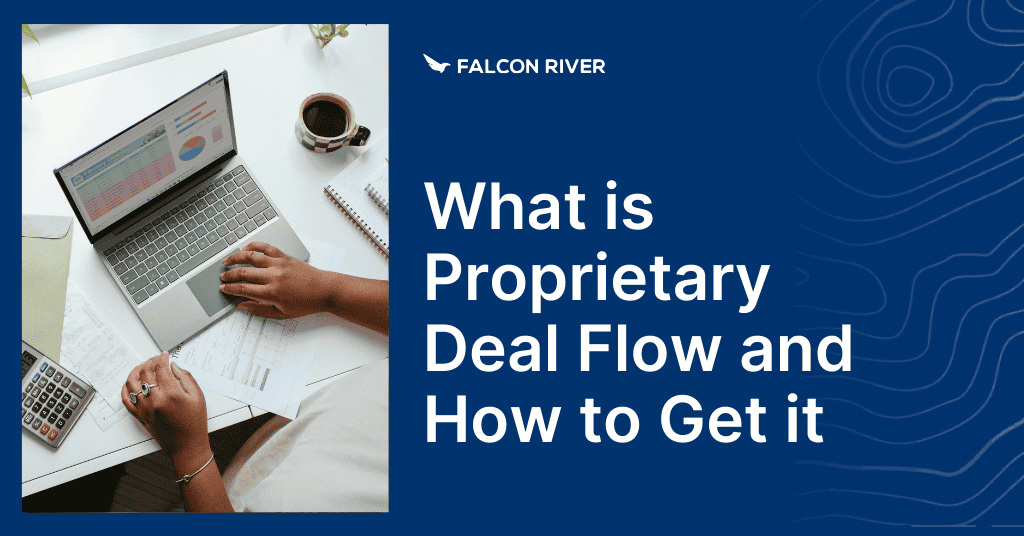
For buyers of small businesses, having a proprietary deal flow could mean the difference between securing an off-market asset that could 10x your portfolio and losing that opportunity to a rival.
TL;DR
- In M&A, a deal flow is an open, semi-open, or private acquisition channel of new business opportunities.
- When a deal flow is proprietary, it means only you and your team have access to these off-market M&A opportunities. If you pass on them, then they’d be passed along to other potential buyers and would no longer be proprietary.
- Success as a PE, VC, business aggregator firm, or serial entrepreneur with an online small business portfolio means finding and buying businesses that no one else knows are on the market yet. Hence the value of a proprietary deal flow.
Let’s dive in . . .
What is Deal Flow?
Deal flow, also known as deal origination is the process of finding businesses that want to be acquired. In other words, sale-ready businesses that want to sell to a purchase-ready buyer; in this case, your business.
According to the U.S. Census Bureau and SBA, there are 33+ million small and medium enterprises (SMEs) in America. Almost all, 99% employ less than 250 people. These businesses are the backbone of the US and global economy.
Out of those 33 million, “roughly 500,000 businesses change hands each year”, based on BizBuySell.com and U.S. governmental data.
Business owners sell for many reasons, including:
- Time for retirement, with no succession plan/someone they want to take over;
- Business in distress. It could still be viable and become profitable with a new owner;
- Want to invest their time/energy, and the money from the sale into something else;
- Personal reasons. Life changes, or a sudden life change means they don’t have the time/energy to keep putting into the business and would benefit financially from the sale.
We help business owners get sale-ready in many ways, including this handy guide for them.
However, not every business owner wants to stick a “For Sale” sign on their digital front lawn. For numerous reasons, not everyone wants to do that.
However, that makes these businesses “off-market”, so they’ll be seeking buyers through numerous channels in the way that buyers also have dozens of ways to reach these potential sellers.
Hence the value of proprietary deal flow, which we’ll explain more about next.
What is Proprietary Deal Flow?
Unlike a public deal flow ⏤ one that other potential buyers can access as easily as you (e.g., online website listings, M&A platforms, even Twitter (X) ⏤ a proprietary deal flow is private, closed, and ideally, only your firm should be aware of the deals in this pipeline.
Like intellectual property (IP), or what used to be known as trade secrets, or “insider deals”, a proprietary deal flow is confidential, and off-limits to outsiders. No other potential M&A rivals should have access to the businesses in this particular opportunity pipeline.
If, after looking at the opportunities, you choose to pass on them then the business owners would be searching for other potential buyers. Many will choose to do this on the open market; but, at least you’ve been given the advantage of weighing up the value of a deal before anyone else.
What are the Advantages of Finding Proprietary Off-Market Deals?
There are numerous advantages of taking the time to set-up a proprietary off-market deal flow, including:
- You’re effectively giving yourself the option of first refusal on any deal that comes through this channel.
- You see deals before anyone else does, giving your firm a distinct advantage.
- Success generates success. Once you become known for giving good terms and closing high-value deals, other potential sellers will start to come your way.
- Referral partners and deal sourcing partners will be more inclined to send you their best deals when they can see you’re as good as your word, keeping proprietary deals off-market and confidential.
- It could be the best way to land that once-in-a-lifetime 10x your portfolio deal because you won’t be competing against others, potentially funds with deeper pockets.
Establishing a proprietary deal flow is a fantastic opportunity to find the best M&A deals that aren’t on the market, and grow your business portfolio in-line with the opportunities that come your way.
5 Steps to Establish a Proprietary Deal Flow
Here are the five steps you need to follow to establish a proprietary deal flow.
- Work with an off-market managed deal flow partner
We established Falcon river because we faced the same challenges, delays, and dead-ends every acquirer and seller has faced. When we couldn’t find a suitable broker, who would be actively looking for us, we thought we’d scratch our own itch here.
When you’re looking for off-market business acquisition opportunities, it really helps if you can find someone who can help you source and manage those off-market deal flows.
Work with Falcon River when you’re searching for new off-market acquisition deals.
- Leverage networks, connections, partners, and referrals
Buying a business is a big decision. Even if you’ve got 10s of 100s of millions to deploy, every acquisition is a big commitment.
After you’ve bought a business, you need a plan to grow it further, invest in it, nurture it, and probably bring on-board new management to run it (unless the founder is staying on for a salary to steer the ship as part of the exit plan). If you want to generate a return from a business acquisition then there’s more work to be done after a deal than before it.
So, with that in mind, trust is crucial. Naturally, that means you should leverage and tap into your networks, connections, partners, and anyone who can refer M&A opportunities your way. Talk to those you trust first, before going beyond your network.
The reason many of us in this business need to go beyond our networks is we soon exhaust opportunities on our doorsteps. We need to start looking further afield, and that’s why other channels are needed.
- Tap into M&A, funding platforms, and online website brokerages
Now, when we say tap into M&A, funding platforms, and online website brokerages (of which there are several leading platforms), we mean have relationships with these companies so you hear about potential deals before they go live.
Once a business is for sale online it’s no longer “off-market”, and nor is it proprietary. In most cases, because these are businesses people are selling, not second-hand furniture, deals have to be checked before they can be published.
In some cases, these platforms will share details with partners, pre-agreed by the sellers, giving you a great opportunity to say you want to take a closer look at an M&A opportunity before it goes to market.
- For VC, Business Aggregators, and Serial Entrepreneurs: Use deal flow management tools
Having the right tools for deal sourcing and deal flow management can make a big difference. Instead of trying to use a CRM (customer relationship management), that’s not equipped for VCs, business aggregators, or serial entrepreneurs, make use of software that’s specifically designed for this sector and your needs.
Here’s our list of the best Deal Flow Management Tools: for VCs, business aggregators, and serial entrepreneurs.
- For PE firms: Use private equity deal flow software tools
Private Equity (PE) firms have somewhat different requirements than VC, business aggregators, and serial entrepreneurs, so we put together a separate list of software you can use for deal sourcing.
For Private Equity (PE) firms, we’ve sourced a separate list of Private Equity (PE) deal flow software here.
How to Make your Proprietary Deal Flow More Efficient
In every deal flow, there are always ways to make it more efficient. Especially if you’re aiming to review 100s of deals every month. The last thing you want to do is overlook one with enormous potential because you were too busy in the details of a smaller deal with a lot less potential.
Here are three ways you can make your proprietary deal flow more efficient:
Implement Automation in your Deal Flow
Automation was around a lot longer than ChatGPT and recent hype around large language models (LLMs) and other forms of generative AI (artificial intelligence) tools.
However, that doesn’t mean you can’t use these and other tools to automate various aspects of your deal flow.
Take a look at two articles we’ve done on deal flow software and management tools, as many of these include automation and AI-based features that will prove very helpful to overwhelmed deal flow managers:
Best Deal Flow Management Tools: for business aggregators and serial entrepreneurs.
For Private Equity (PE) firms, we’ve sourced a separate list of Private Equity (PE) deal flow software here.
Establish Effective Custom Scoring for Deal Sourcing Origination
Do you and your team know how to spot a good deal, or does it come down to gut instinct?
Hopefully, it’s a mix of data and experience, a feeling, we know as gut instinct. On the data side, give every deal a weighting (say, out of 10) for everything your team needs to review before and during due diligence, such as:
- Cashflow and projections to show Discounted cash flow (DCF)
- Cash-on-hand and current receivables
- P&L and the balance sheet
- Revenues (MRR, ARR)
- Assets, intellectual property
- Customers, customer loyalty
- Product/service ranges
- Whether they’re pre-qualified for a seller-financed SBA-guaranteed loan?
- What are their current assets, liabilities, EBITDA, and discounted cash flow?
- Do they have a realistic valuation in mind, ideally one prepared by a professional valuation analyst?
- Based on everything, what does the post-purchase growth potential look like?
There are numerous factors, including gut instinct, of course, so it’s useful to have a scoring system to help you make more effective decisions with every proprietary deal that crosses your desk.
Ensure Outreach and Inbound Deal Sourcing is Consistently High-Quality
Like any marketing or sales activity, quality and consistency are key.
Deals won’t come to you unless you implement a strategy designed to leverage every channel at your disposal to drive new M&A opportunities your way, including working with deal flow partners.
Relationships need to be maintained.
At the same time, if you’ve launched inbound, SEO (search engine optimization), social media, newsletter, podcast, PR, or any type of thought-leadership approach to marketing, then keep doing that for at least 6 to 12 months.
Anything like that takes time. Working with deal flow partners or outbound/cold outreach takes less time/has a shorter timescale to achieve an ROI. Want true success in establishing a proprietary deal flow? Do inbound and outbound marketing and sales.
Have deals coming your way via every channel, increasing your chances of success and finding a deal before anyone else does.
Key Takeaways: Proprietary Deal Flow
Having a proprietary deal flow gives your company an advantage in M&A. You see deals before anyone else gets the chance. They’ve come to you first, or you’ve been referred to them by a trusted deal-sourcing partner. Either way, you can review the details first before competitors or they’re published online.
There are a few ways to establish and optimize a proprietary deal flow, including:
- Work with a trusted managed deal sourcing partner;
- Establishing and implementing a multi-channel digital marketing campaign that will bring M&A opportunities your way;
- Using automation and custom scoring when weighing the potential value of M&A deals.
We also recommend working with a deal-sourcing partner who will send purchase-ready acquisition targets that are the best fit for your firm.
Work with Falcon River when you’re searching for new off-market acquisition deals.

